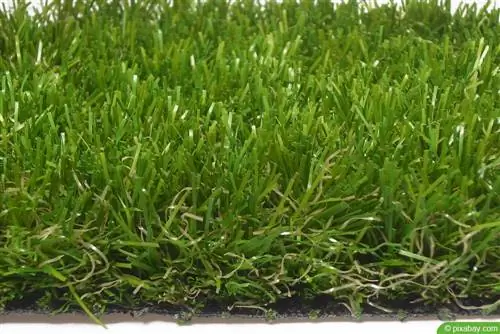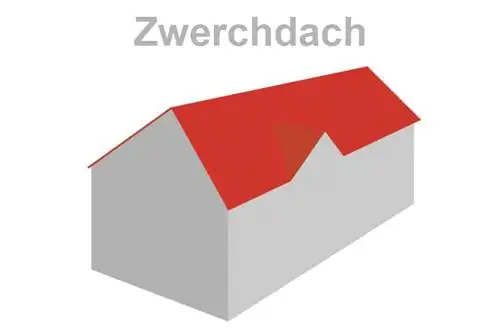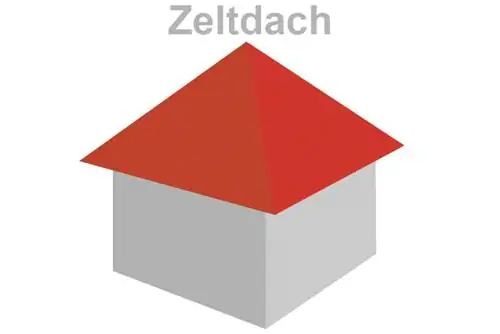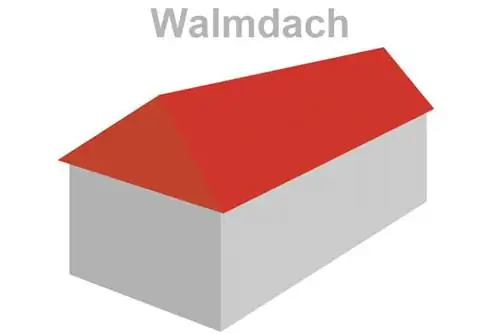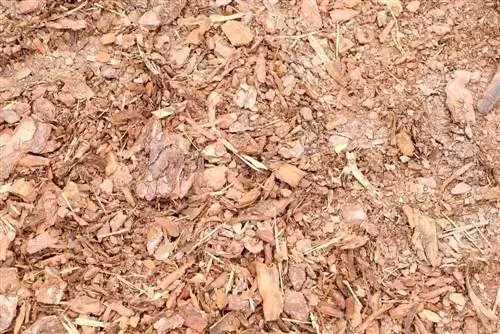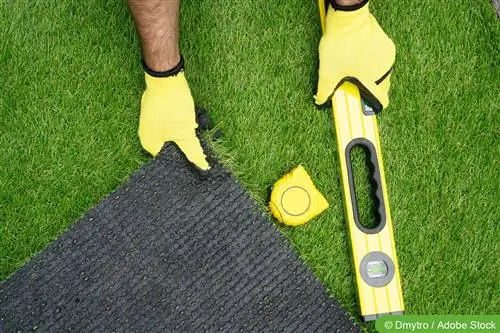- Author admin [email protected].
- Public 2023-12-17 03:39.
- Last modified 2025-06-01 06:48.
Many people are familiar with artificial turf on the balcony or on the sports field - but the decorative variants for the garden are still comparatively unknown. They have some advantages to offer. However, artificial turf is not free from disadvantages either. Therefore, a few questions should be clarified before purchasing and not only the prices for the lawn and the costs for laying should be taken into account.
Advantages of artificial turf
Some of the advantages of artificial turf are obvious. It stays green even in dry weather and the blazing sunlight in summer and does not discolor or shrink. However, there are also other advantages, such as:
Allergies
Grasses can be an enormous burden for people with a corresponding allergy. However, the development of allergens cannot always be avoided if the lawn is not mowed often and thoroughly enough. Artificial lawn does not pose this risk.
Fertilize
The supply of fertilizers is of course not necessary for the artificial lawn. This saves costs and effort. This applies not only to the amount of work involved, but also to the fact that no soil samples need to be taken and tested in order to ensure an appropriate supply of nutrients.
Insects and Pests
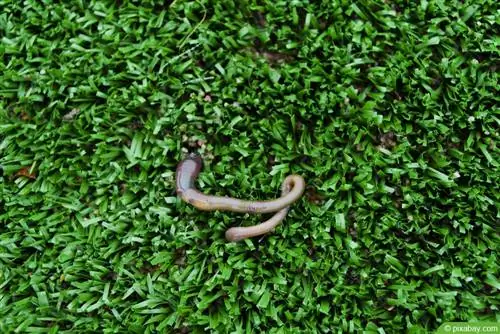
Neither insects nor other pests are attracted to the artificial meadow. This also significantly reduces the effort required to maintain the lawn.
Mowing
In the warm seasons, the grass plants can literally shoot up. Under optimal conditions at the location, the lawn grows around six centimeters per week. So that the plants have dense branching and are particularly resilient - but if possible do not form any spikes - they should be mowed once or twice a week from spring to late summer. Especially on larger properties, this can be extremely complex and take a lot of time. The artificial lawn makes work considerably easier here.
Reseeding
With natural grass, various influences can cause plants to die. Spreading moss, weeds but also moles, voles and objects standing or lying on the lawn can damage the grass plants and require re-sowing of lawn seeds. Such cases cannot occur with an artificial lawn, which eliminates the effort.
blasting
In very warm and dry phases, every natural lawn should be watered accordingly. Otherwise, even a he althy and otherwise well-maintained lawn can quickly become damaged, dry out or burn. The artificial turf resists the effects of drought and therefore saves water, work and money.
Embarrassed
Lawns need some time to grow and be walkable. The artificial version, on the other hand, is ready and usable immediately after laying.
Verticutting
Dethatching is an important care measure for the lawn, removes moss and other thatch, aerates the soil and can therefore ensure better growth. However, this measure is strenuous because it requires a comparatively high amount of force. With artificial turf, care is much simpler and easier.
Versatility
Lawn made of synthetic fibers can also be laid on the balcony of the roof terrace or terrace
Disadvantages of artificial turf
Although artificial lawns have some advantages over real grass plants, they also have disadvantages. These consist of:
- limited installation options on slopes and hills
- Fibers can be flattened
- higher acquisition and installation costs
- no change over the year
- professional laying increases costs additionally
- Cleaning required
- less habitat for insects, therefore less food for birds and other beneficial insects
- may fade in sunlight
- Weeds can grow through it
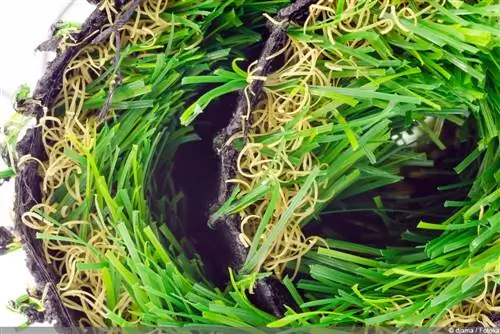
In addition, playing on grass made of synthetic fibers is often a little more dangerous. If children fall or slip on real grass, the consequences are usually limited to a few patches of grass. However, abrasions can occur on the synthetic fibers. However, this risk depends on the exact type of artificial turf. Whether artificial or real lawn is the better choice for your own needs can only be clarified individually.
Prices
The prices for artificial turf vary greatly. Simple versions for the garden or balcony are available for around ten euros per square meter. They are generally not particularly resilient and often have a shorter lifespan. For particularly high-quality variants that are very resilient, resistant and look particularly natural, you can expect prices of 30 to 40 euros.
There may also be other materials, such as sand or granules, which are required for infilling with some types of artificial turf. However, these are comparatively inexpensive and only make up a small part of the total costs.
Costs
The total cost of artificial turf is made up of various factors. These were:
- Type of artificial turf or price per square meter
- required area
- possibly preparatory leveling of the area
- removal of old lawn if necessary
- Costs for professional laying
- Shipping or delivery costs
- additional material, such as sand or granules
The following examples can be used for clarification:
A garden with a lawn area of 125 square meters is to be equipped with lawn made of synthetic fibers. For laying, sprinkling with special lawn sand is required. Depending on the type of lawn, the height of the fibers and the required weight, around 100 to 200 kg of sand or granules must be planned.
Simple lawn made of synthetic fibers for low load - 9.95 EUR / sqm
9, 95 EUR x 125 sqm=1,243, 75 EUR
Lawn sand for bedding 18.99 EUR for 100 kg, 37.98 EUR for 200 kg.
For the material alone this results in:
- 1,243.75 + 18.99=1,262.74 EUR
- 1,243.75 + 37.98=1,281.73 EUR
The shipping costs and prices for professional laying as well as preparatory work such as leveling the area or removing the existing lawn vary greatly from provider to provider. On the one hand, this means that no general statements can be made about the overall price. On the other hand, it is also worth comparing the offers with each other.
Embarrassed
If the lawn made of synthetic fibers is to be laid on a balcony or roof terrace, this can easily be done by even laypeople. The lawn is simply rolled out and cut to the required length. As with carpet, it makes sense to let the lawn “lay out” for several hours or a day before cutting. As a result, any deformations caused by rolling are no longer present and cutting can be carried out more easily and in a more coordinated manner.
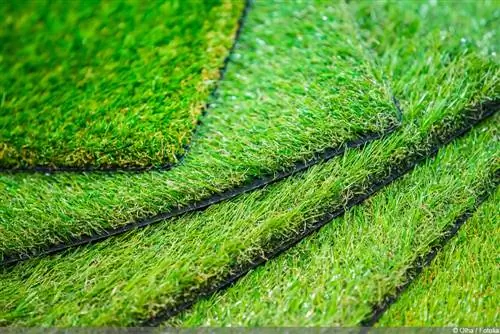
In gardens, however, installation should be carried out professionally to avoid problems and unfavorable results. This means that the overall purchase costs are higher, but annoyances such as gaps, protruding or overlapping edges are avoided. In addition, the use of granules or sand can be better planned and clarified.
Lawn sand - function
After laying the artificial turf, special granules or sand can be applied to achieve various benefits:
Complaint
The special sand weighs down the lawn and ensures that it stays as desired and as it was aligned.
Stability
Especially with longer fibers, which result in a softer and taller lawn, sand or granules are useful or even necessary to stabilize the “culms”. Filling in the material increases stability and therefore ensures better stability.
Lifespan
The sand can extend the lifespan of the lawn as walking and other stresses on the artificial lawn are better absorbed.
Preventing wrinkles
Due to the weight, the lawn made of synthetic fibers does not move and slip so easily. This prevents wrinkles.
Sprinkling sand is therefore always advisable if:
- Fire protection is required
- the lawn should look particularly natural
- the lawn is used intensively
- stronger influences such as significant temperature fluctuations
- Moving and shifting of the lawn should be prevented
Cleaning and care
Although the artificial turf doesn't need to be mowed or fertilized, it doesn't need to be cared for. Above all, cleaning should not be neglected in order to prevent damage to the lawn. It is important to remove larger foreign bodies such as leaves with a leaf blower or leaf vacuum. Animal droppings, twigs, stones or other dirt should also be collected regularly. Care must be taken to ensure that the granules or sand are not also removed. If necessary, if the sand is blown away or removed, it must be sprinkled to replace the amount removed.
Tip:
For maintenance, it is important to hook and brush the lawn at regular intervals. This straightens the fibers and preserves the natural look.

